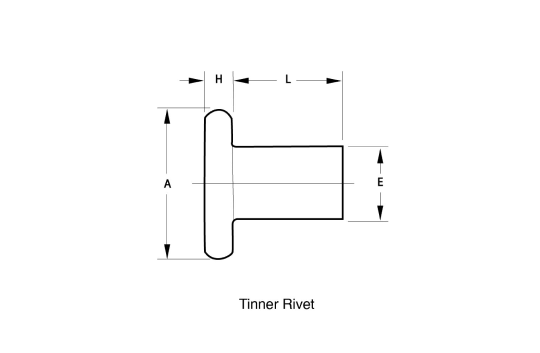PRAIRIE RIVET
Other Rivets
Tinner rivets, tinner’s rivets, or tinman’s rivets get their names from being most often used to join together pieces of thin sheet metal. These solid, flat-headed rivets with relatively short lengths, can be found frequently used in HVAC applications.
How tinner rivets work: For installation, a tinner rivet is inserted from the underside of the workpiece through a pre-drilled hole.
The flathead should be placed on top of an anvil or similarly large, flat, sturdy surface. From there, a rivet set is placed on the shaft or shank end of the rivet.
The rivet set is then struck with a hammer to flatten the shaft, creating a second, round head that holds the joined materials in place.
Common Materials Used For Tinner Rivets
- Steel
- Stainless Steel
- Aluminum
- Brass
- Copper
- Monel
How To Measure Tinner Rivets
Wire Range: .084 to .242
Tinner Rivet Charts

| Nominal Size Number | Shank Diameter | Head Diameter | Head Height |
|---|---|---|---|
| 8oz | 0.091 - 0.085 | 0.225 - 0.205 | 0.036 - 0.024 |
| 10oz | 0.097 - 0.91 | 0.25 - 0.23 | 0.037 - 0.025 |
| 14oz | 0.111 - 0.105 | 0.276 - 0.255 | 0.038 - 0.026 |
| 1.25 # | 0.122 - 0.116 | 0.295 - 0.275 | 0.045 - 0.033 |
| 2 # | 0.146 - 0.14 | 0.341 - 0.319 | 0.05 - 0.036 |
| 2.5 # | 0.15 - 0.144 | 0.311 - 0.289 | 0.069 - 0.055 |
| 3 # | 0.163 - 0.154 | 0.329 - 0.303 | 0.073 - 0.059 |
As A Full-Service Rivet Company
We offer rivets in a range of sizes and materials to meet the needs of your fastener application.
- Tinners Rivets
- Mil-Spec
- Countersunk Head Rivets
- Self Piercing Rivets
- Custom Rivets
Ready To Start Your Next Rivet Order?
Order the solid rivets you need, request a quote, or contact us to talk with a member of our Prairie Rivet team to learn more. We will be happy to assist you.
